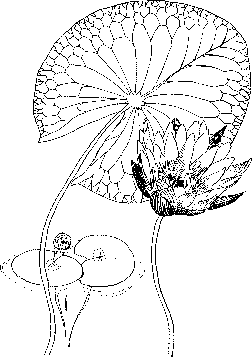Common Aquatic Plant Management Problems
Please note:
This information is intended for educational purposes only. References to commercial
products or trade names are made with the understanding that no discrimination is intended of
other products which may be available. Any herbicides recommended herein for the treatment
of aquatic vegetation have been registered by the Environmental Protection Agency for use
in the manner described. The registration and use of a particular product may change
therefore the information provided here may not remain current indefinitely. It is the
responsibility of the user to read and follow the manufacturer's label to prevent misuse
of the product.
Fragrant Water Lily

Scientific Name - Nymphaea odorata
Common Name - White water lily
Distribution and Habitat
This aquatic species is found statewide but most frequently in the upper and lower coastal plain. The water lily prefers older established ponds with thick organic "muck" or silt bottoms. It may be found rooted in depths of up to eight feet in clear water conditions, although generally it thrives in shallower waters. The prolific nature of this plant often causes considerable problems.
Description
The water lily is a rooted aquatic species possessing a large heart-shaped leaf 6"-10" wide which lies flat on the water surface. The plant has a long fibrous stem and is rooted by means of thick, fleshy rhizomes buried within the bottom sediments. Numerous leaf veins radiate out from the point of attachment of the stem on the underside of the leaf. The plant produces a fragrant, white flower 3 - 5" wide during the warmer months. This flower is composed of numerous white petals with a yellow center.
Recommended Control Methods
1. Granular 2, 4-D
Active Ingredients: Ester of 2, 4-Dichlorophenoxyacetic acid
Product Name: Aqua-Kleen; Riverdale; Weedtrine II
Approximate Cost: $1.80/lb - $90.00/50lbs.
Application Rates: 100 - 150lbs/acre (100lbs./acre is equivalent to
approximately 5 lbs./2000 sq. ft.)
Application Methods and Tips:
Granular 2, 4-D is most effective against water lilies during early season growth before the plants mature. The product should be broadcast using a fertilizer or seed spreader to ensure uniform coverage of the treatment area. Control will generally be confined to those areas where the herbicide is applied. Higher rates will be required in areas of dense growth, water greater than five feet deep or ponds with a short retention time (high volume turnover). Care should be exercised when treating heavily vegetated ponds to prevent oxygen depletions due to decomposing plants. No more than one-third of the pond should be treated at once, allowing 14-21 days between applications. Certain water use restrictions apply to the use of this herbicide. Additional product directions and precautionary statements are listed on the herbicide container. READ AND FOLLOW THE HERBICIDE LABEL.
2. Sonar
Active Ingredients: Fluridon
Product Names: Sonar AS; Sonar SP
Approximate Cost: Sonar AS (liquid formulation) $300.00/quart
Sonar SP (granular formulation) $600.00/40lbs.
Application Rates:
| Average water depth | Liquid formulation | Granular formulation |
|---|---|---|
| Less than 3 feet | .50 - .75 quarts/acre | 10 - 15 lbs/acre |
| 3 - 5 feet | .75 - 1.0 quarts/acre | 15 - 20 lbs/acre |
| Greater than 5 feet | 1.0 - 1.5 quarts/acre | 20 - 30 lbs/acre |
Application Methods and Control Tips:
This product should not be applied to
ponds with short retention times, (high volume turnover). Sonar AS should be mixed with
water (1 qt to 30 gals. water) and applied evenly over the treatment area. Sonar SP may
be broadcast using a fertilizer or seed spreader to ensure even coverage. Best
results are obtained when plants begin active growth in the spring. Herbicidal affects
may not be noticeable until 6-12 weeks after treatment. Additional product directions
and precautionary statements are listed on the herbicide container.
READ AND
FOLLOW THE HERBICIDE LABEL.
Consult the fisheries biologist serving your county or more details concerning use of these products.
3. Sterile Grass Carp (White Amur)
Grass carp are not considered an effective alternative for the control of fragrant water lily.
The above information is available as a downloadable PDF - Fragrant Water Lily
